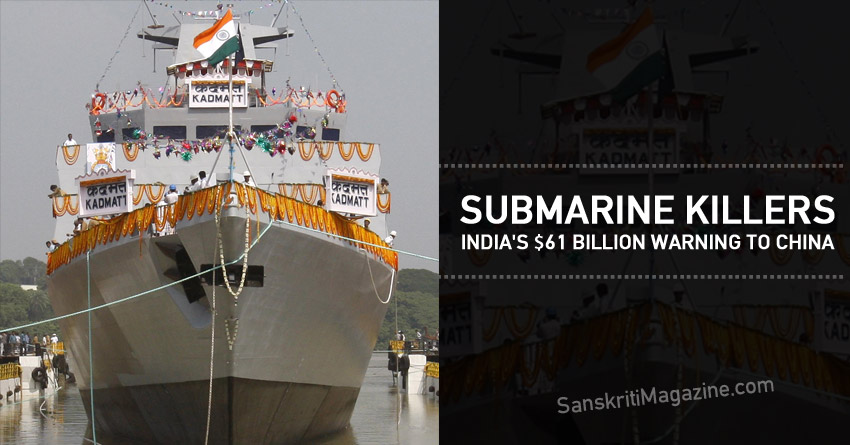Submarine Killers: In a dock opening onto the Hooghly River near central Kolkata, one of India’s most lethal new weapons is going through a final outfit.
The Kadmatt is a submarine killer, bristling with technology to sniff out and destroy underwater predators. It’s the second of four warships in India’s first dedicated anti-submarine force — a key part of plans to spend at least $61 billion on expanding the navy’s size by about half in 12 years.
The build-up is mostly aimed at deterring China from establishing a foothold in the Indian Ocean. It also serves another goal: Transforming India’s warship-building industry into an exporting force that can supply the region, including U.S. partners in Asia wary of China’s increased assertiveness.
“India’s naval build-up is certainly occurring in the context of India moving towards a greater alignment with U.S. and its allies to balance China,” said David Brewster, a specialist in Indo-Pacific security at the Australian National University in Canberra. “India wants to be able to demonstrate that Beijing’s activities in South Asia do not come without a cost, and Delhi is also able to play in China’s neighborhood.”
China showed its growing naval prowess when it deployed a nuclear-powered submarine to patrol the Indian Ocean for the first time last year, while a diesel-powered one docked twice in Sri Lanka. India says another Chinese submarine docked in May and July in Pakistan, which is reportedly looking to buy eight submarines in what would be China’s biggest arms export deal.
Obama Help
The U.S.’s Seventh Fleet has patrolled Asia’s waters since World War II and is backing India’s naval expansion. On a January visit to New Delhi, President Barack Obama pledged to explore ways of sharing aircraft carrier technology. The two countries also flagged the need to safeguard maritime security in the South China Sea, where neither has territorial claims.
India’s present fleet of 137 ships falls far short of the more than 300 vessels in China, which has Asia’s biggest navy. China boasts at least 62 submarines, including four capable of firing nuclear ballistic missiles, according to the Pentagon.
“We would like to have the Moon,” Navy Vice Chief P. Murugesan told reporters on July 14, acknowledging that its goal of a 200-ship navy by 2027 was ambitious.
The vessels on India’s wish list show Prime Minister Narendra Modi’s intent on expanding the navy’s influence from Africa to the Western Pacific. Most of them will be made in India, a sign that moves to upgrade the country’s shipyards are starting to pay off for the world’s biggest importer of weapons.
100 Warships
India plans to add at least 100 new warships, including two aircraft carriers, as well as three nuclear powered submarines capable of firing nuclear-tipped ballistic missiles. It will also tender for submarine-rescue vessels, a first for a navy that’s operated submarines for four decades.
“What we are seeing here is a significant ramping up of blue-water capacity,” said Collin Koh Swee Lean, an associate research fellow at the S. Rajaratnam School of International Studies in Singapore. The expansion would help maintain India’s regional naval supremacy and project power, he said.
Part of that strategy involves overseas sales. India recently made its first ever warship export to the island nation of Mauritius. The patrol vessel was built by Kolkata-based Garden Reach Shipbuilders and Engineers Ltd., one of four government-run shipyards.
The same company is bidding to win a Philippine tender for warships, and last year India agreed to sell Vietnam four offshore patrol boats. Both nations compete with China for territory in disputed waters.
Billionaire Invests
India wants to produce all of the components on its naval vessels domestically by 2030, Navy Chief Admiral RK Dhowan said this month. Now it only makes about a third of weapons and sensors, and about 60 percent of propulsion systems.
To make that happen, Dhowan wants private firms involved. Billionaire Anil Ambani said this month his Reliance Anil Dhirubhai Ambani Group Ltd. would make a 50 billion rupee ($780 million) investment in a shipyard on India’s western coastline.
While India is capable of building warships, it relies on the U.S., Russia and Europe for technology and lags the world’s bigger players, according to Siemon Wezeman, a senior researcher at the Stockholm International Peace Research Institute.
“India does not have a very glorious record in defense manufacturing, and certainly not for exports,” he said. “Things may change for the better with the private sector.”
India is also reaching out to the region. It’s boosting ties with Mauritius and Seychelles, and has offered to help Myanmar modernize its navy. India is also hosting naval exercises with the U.S. and Japan later this year, and holding its first-ever drills with Australia in September.
Chinese experts led by Defense Ministry spokesman Senior Colonel Yang Yujun told Indian media this month that clashes are possible if India views the adjacent ocean as its “backyard.”
“India wants to take a leadership role in the Indian Ocean and ultimately become the predominant naval power,” ANU’s Brewster said. “Its moves reflect an instinctive view among many in Delhi that if the Indian Ocean is not actually India’s Ocean, then in an ideal world it ought to be.”
~By David Tweed and Nc Bipindra (Blookberg Business)











